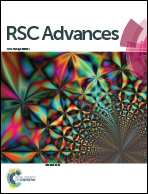Strychnos nuxvomica, Piper longum and Mucuna pruriens seed extracts as eco-friendly corrosion inhibitors for copper in nitric acid
Abstract
The inhibitive effect of the Strychnos nuxvomica (SN), Piper longum (PL) and Mucuna pruriens (MP) seeds extract on the corrosion of copper in 3 M HNO3 solution was studied using gravimetric, potentiodynamic polarization and electrochemical impedance spectroscopic (EIS) studies. Inhibition efficiency increased with increasing concentration of the extract and maximum inhibition efficiency was 91.60%, 80.00% and 71.6% obtained from gravimetric studies at 0.2 g L−1 of SN, PL and MP respectively. Above this concentration no noticeable change was observed. The adsorption of the inhibitor on copper surface was in accordance with the Langmuir adsorption isotherm. Potentiodynamic polarization study showed predominantly cathodic type inhibition. SEM and AFM study was carried out to support the inhibition data.


 Please wait while we load your content...
Please wait while we load your content...